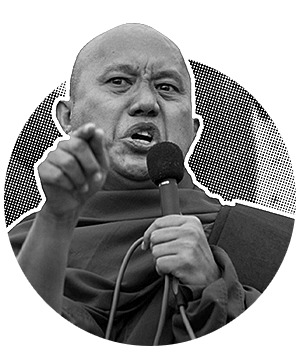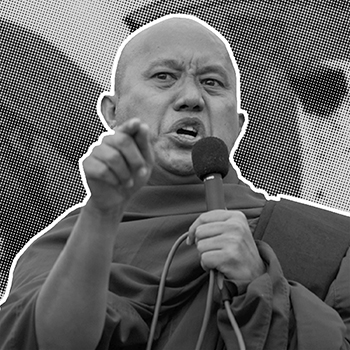
NOT BE CONSIDERED CRIMINAL
Introduction: Hate Speech as
Persecution in Post-2011 Myanmar
Hate speech may be a critical component of a mass atrocity campaign even when it is not necessarily directly calling for violence. This was the case in post-2011 Myanmar, where Ashin Wirathu used social media to dehumanize the country’s minority Rohingya Muslim population during a widespread and/or systematic attack against them. Such speech is potentially chargeable as the crime against humanity of persecution, but the law is not clear in this regard.
“In every town, there is a crude and savage Muslim majority…who target innocent young Burmese girls and rape them.” — Ashin Wirathu
Myanmar (formerly Burma) is a Southeast Asian nation whose majority Buddhist Bamar people share the country with over 100 ethnic groups, including the Rohingya, a predominately Muslim minority living in North Rakhine State, just south of Bangladesh.
During post-British independence, the Rohingya faced civic exclusion and state harassment under Burma’s authoritarian regimes (1962–2011).
In 2012, after democratic elections, the Rohingya were attacked by local Buddhists, evidencing a pattern of ethnic cleansing.
These attacks were inflamed by extremist Buddhist hate speech – especially via the mouthpiece of prominent monk, Ashin Wirathu.
For example, on social media, Wirathu declaimed: “In every town, there is a crude and savage Muslim majority,” and he warned about Muslims who “target innocent young Burmese girls and rape them.”
He also said that “Muslims are like the African carp. They breed quickly, and they are very violent and they eat their own kind. Even though they are minorities here, we are suffering under the burden they bring us.”
This speech dehumanized the Rohingya and instilled hatred in the majority toward them but did not represent direct calls to commit violence against them.

- Systemic Attack A widespread or systematic attack against a civilian population;
- Knowledge of Attack Knowledge of the attack on the part of the speaker;
- Deprivation of Rights A fundamental deprivation of the target group’s rights that results from the speech (and is as grave as the other enumerated types of crimes against humanity, such as deportation, imprisonment, and apartheid);
- Deprivation: Group Status The rights deprivation being motivated by the group status.
01
Systemic
Attack
A widespread or systematic attack against a civilian population;
02
Knowledge
of Attack

Knowledge of the attack on the part of the speaker;
03
Deprivation
of Rights

A fundamental deprivation of the target group’s rights that results from the speech (and is as grave as the other enumerated types of crimes against humanity, such as deportation, imprisonment, and apartheid);
04
Deprivation:
Group Status

The rights deprivation being motivated by the group status.
It is unclear whether a court could prosecute Wirathu’s speech as the crime against humanity (CAH) of persecution. This is because there is a split between the ICTR and ICTY on whether hate speech not directly calling for action can be charged as CAH-persecution.
In the Media Case, the ICTR reasoned that such hate speech could be charged because it was knowingly uttered as part of a widespread or systematic attack against a civilian population – but the ICTY, in the Kordic decision, concluded that free speech considerations dictated against charging such speech.
Thus, even though Wirathu’s speech was knowingly uttered as part of a widespread and/or systematic attack against a civilian population, and may have sparked and/or fueled violence against the Rohingya, it could go unpunished.
PREVIOUS CASE STUDY
01 — Callixte Kalimanzira | Rwanda
NEXT CASE STUDY
03 — Vojislav Šešelj | Bosnia and Herzegovina












